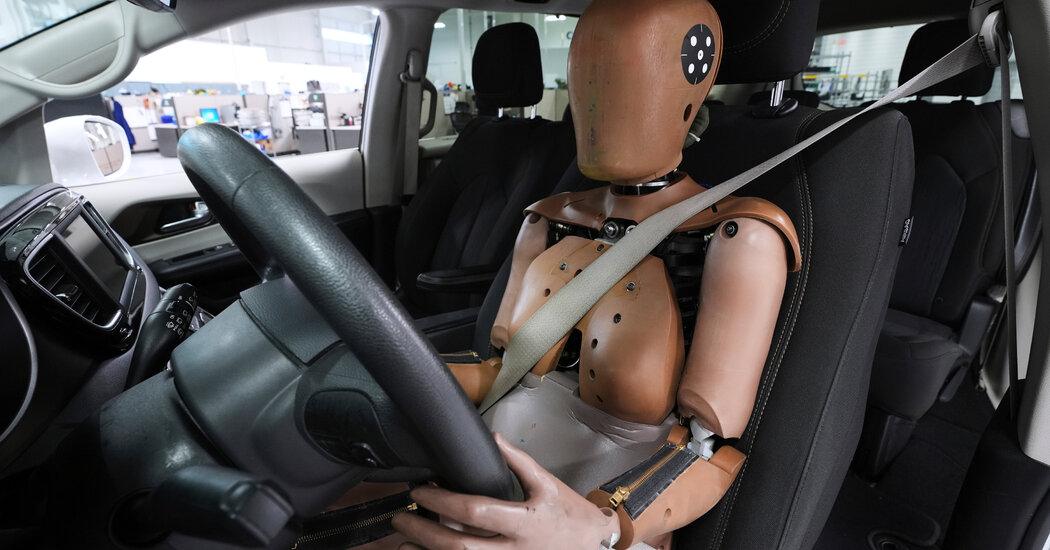Today, when a woman gets behind the wheel of a vehicle, she is protected by safety features – from seat belts to airbags – that were largely designed to protect the average man about 50 years ago.
But in the United States, female drivers are 73 percent more likely than male drivers to be seriously injured in car crashes, and they are 17 percent more likely to die, according to government data.
These higher risks prompted the Federal Ministry of Transport to approve a new female mannequin, announced Thursday. Known as the THOR-05F, it is “more durable, more precise and more realistic,” according to the government.
“Better understanding the unique ways that women are impacted differently in crashes than men is critical to reducing traffic fatalities,” said Jonathan Morrison, administrator of the National Highway Traffic Safety Administration.
Once a final rule is adopted, this women’s model could replace the so-called Hybrid III, which has been used for decades in the government’s five-star vehicle crash testing program.
The Hybrid III is based on the proportions of the average American man in the 1970s, who were approximately 5 feet 9 inches tall and 170 pounds.
Much of the safety disparity between men and women can be linked to “a vehicle’s design and technology,” according to a 2005 government report, although the death rate among women has fallen rapidly in newer cars.
In 2011, the National Highway Traffic Safety Administration updated its rating system to include testing with female mannequins, approximately 4 feet 11 inches tall and 108 pounds, with a rubber jacket around their chest to represent breasts.
But most of those tests required the female dummy to be tested in the passenger seat or backseat, not the driver’s seat, even though licensed female drivers outnumber licensed male drivers by about three million.
Although the Department of Transportation has approved the specifications of the new dummy, its adoption in National Highway Traffic Safety Administration automobile safety testing or federal motor vehicle safety standards is not guaranteed.
The government could use the female model in its tests, and it would be made available to manufacturers and the automobile industry. Legislation introduced in Congress seeks to make its use mandatory.
“The Trump administration deserves enormous credit for this powerful development,” said Maria Weston Kuhn, founder and president of the Drive Action Fund, which aims to make cars safer for women.
Ms. Kuhn, a student at New York University Law School, was seriously injured in an accident in 2019 when she was an undergraduate. She and her mother were in the back seat and both were injured, but not her father and brother, who were in the front seats and closest to the collision point.
She began lobbying Congress to pass a bill requiring federal regulators to use the female mannequin and test it in the driver’s seat.
Each mannequin costs about $1 million, and the Congressional Budget Office estimated that adding it would cost the entire auto industry between $50 million and $60 million.
“The fight is far from over,” Ms. Kuhn said. “Now is the time for automakers to tell us how they are going to be part of the solution to protect women’s lives, not a bump in the road.”
Although federal officials have stressed that the new female mannequin has more than 150 sensors and more accurately reflects differences between men and women, including the shape of the neck, collarbone, pelvis and legs, it may not be adopted quickly.
The Insurance Institute for Highway Safety, a nonprofit group funded by auto insurers and insurance associations, said its research found the injury risk gap between men and women has narrowed significantly in recent years.
A spokesman for the group, Joe Young, attributed the improvements to better crumple zones, which absorb the force of a crash before it reaches the cabin, and more advanced restraint systems.
“While we continually evaluate new tools that become available, we have no plans to adjust the dummies used in our consumer evaluation crash tests at this time,” Mr. Young said.
He highlighted virtual crash testing as a promising solution to address the injury risk disparity between men and women.
Virtual testing uses computer-generated human models with skeletons and muscles that can be adapted to different ages and sizes, representing the full anatomical diversity of the population.
But a government testing system without physical mannequins isn’t here yet.
“It’s long past time to make permanent these testing standards, which will help save thousands of lives and make America’s roads safer for all drivers,” said Sen. Deb Fischer, Republican of Nebraska, who introduced legislation that would require the most advanced testing devices available, including the new female crash test dummy.




